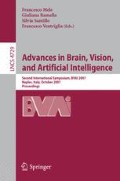Abstract
The aim of this paper is to introduce a novel, biologically inspired approach to extract visual features relevant for controlling and understanding reach-to-grasp actions. One of the most relevant of such features has been found to be the grip-size defined as the index finger-tip - thumb-tip distance. For this reason, in this paper we focus on this feature. The human visual system is naturally able to recognize many hand configurations – e.g. gestures or different types of grasps – without being affected substantially by the (observer) viewpoint. The proposed computational model preserves this nice ability.
It is very likely that this ability may play a crucial role in action understanding within primates (and thus human beings). More specifically, a family of neurons in macaque’s ventral premotor area F5 have been discovered which are highly active in correlation with a series of grasp–like movements. This findings triggered a fierce debate about imitation and learning, and inspired several computational models among which the most detailed is due to Oztop and Arbib (MNS model). As a variant of the MNS model, in a previous paper, we proposed the MEP model which relies on an expected perception mechanism. However, both models assume the existence of a mechanism to extract visual features in a viewpoint independent way but neither of them faces the problem of how this mechanism can be achieved in a biologically plausible way. In this paper we propose a neural network model for the extraction of visual features in a viewpoint independent manner, which is based on the work by Poggio and Riesenhuber.
Access this chapter
Tax calculation will be finalised at checkout
Purchases are for personal use only
Preview
Unable to display preview. Download preview PDF.
References
Rizzolatti, G., Luppino, G., Matelli, M.: The organization of the cortical motor system: new concepts. Electroencephalogr. Clin. Neurophysiol. 106, 283–296 (1998)
Gallese, V.: A neuroscientific grasp of concepts: from control to representation. Phil. Trans. Royal Soc. London (2003)
Arbib, M.: From monkey-like action recognition to human language: An evolutionary framework for neurolinguistics. Behavioral and Brain Sciences 28(2), 105–124 (2005)
Umilta’, M., Kohler, E., Gallese, V., Fogassi, L., Fadiga, L., Keysers, C., Rizzolatti, G.: I know what you are doing: A neurophysiological study. Neuron 31, 155–165 (2001)
Oztop, E., Arbib, M.: Schema design and implementation of the grasp-related mirror neuron system. Biological Cybernetics 87(2), 116–140 (2002)
Demiris, Y., Johnson, M.: Distributed, predictive perception of actions: a biologically inspired robotics architecture for imitation and learning. Connection Science 15, 231–243 (2003)
Prevete, R., Santoro, R., Mariotti, F.: Biologically inspired visuo-motor control model based on a deflationary interpretation of mirror neurons. In: CogSci2005 - XXVII Annual Conference of the Cognitive Science Society, pp. 1779–1784 (2005)
Riesenhuber, M., Poggio, T.: Neural mechanisms of object recognition. Current Opinion in Neurobiology 12, 162–168 (2002)
Santello, M., Soechting, J.: Gradual molding of the hand to object contours. J. Neurophysiol. 79, 1307–1320 (1998)
Jeannerod, M.: Intersegmental coordination during reaching at natural visual objects. In: Attention and Performance. Hillsdale, pp. 153–168 (1981)
Santello, M., Flanders, M., Soechting, J.: Patterns of hand motion during grasping and the influence of sensory guidance. J. Neurophysiol. 22(4), 1426–1435 (2002)
Serre, T., Wolf, L., Poggio, T.: Object recognition with features inspired by visual cortex. In: CVPR (2), pp. 994–1000 (2005)
Bishop, C.: Neural Networks for Pattern Recognition. Hinton (1996)
Author information
Authors and Affiliations
Editor information
Rights and permissions
Copyright information
© 2007 Springer-Verlag Berlin Heidelberg
About this paper
Cite this paper
Prevete, R., Santoro, M., Catanzariti, E., Tessitore, G. (2007). A Neural Network Model for a View Independent Extraction of Reach-to-Grasp Action Features. In: Mele, F., Ramella, G., Santillo, S., Ventriglia, F. (eds) Advances in Brain, Vision, and Artificial Intelligence. BVAI 2007. Lecture Notes in Computer Science, vol 4729. Springer, Berlin, Heidelberg. https://doi.org/10.1007/978-3-540-75555-5_12
Download citation
DOI: https://doi.org/10.1007/978-3-540-75555-5_12
Publisher Name: Springer, Berlin, Heidelberg
Print ISBN: 978-3-540-75554-8
Online ISBN: 978-3-540-75555-5
eBook Packages: Computer ScienceComputer Science (R0)

